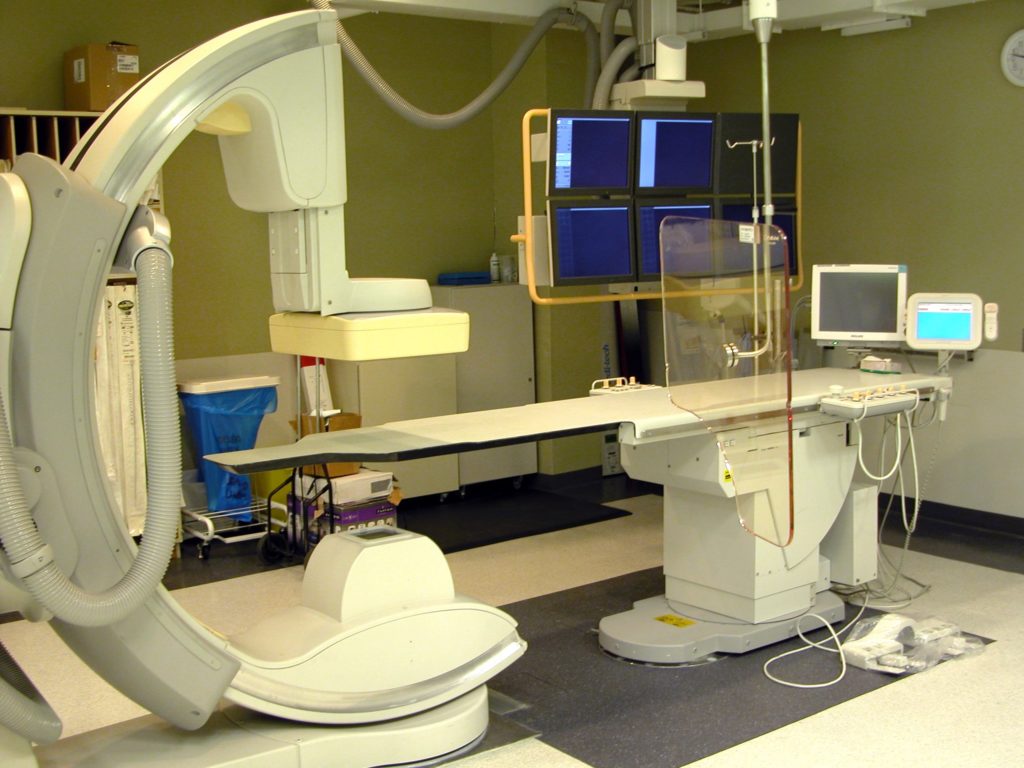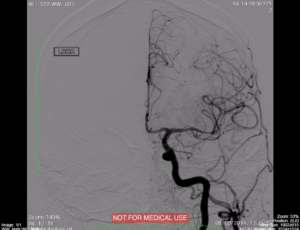22
This modality relies upon x-rays to create images. It is a fluoroscopy unit with advanced features required for vascular and other interventional procedures. For discussion regarding the creation of x-rays used for fluoroscopy, see the X-ray section.
An angiography machine is essentially a fluoroscopy unit that has the added feature of having the x-ray source and detectors mounted on a c-arm apparatus. The c-arm allows for movement of the source and detector around the patient who lies supine on the angiography table. The operator can acquire images in a wide variety of anatomic projections. Therefore, patient movement is not required for this imaging modality. The angiography unit also has advanced software applications that facilitate complex arterial and body interventional procedures beyond the capabilities of a standard fluoroscopy unit. As with fluoroscopy, the images are viewed inverted in comparison to standard radiographs.
The x-ray dose for Angiography is controlled by multiple detectors that adjust the radiation exposure to maximize image quality and minimize x-ray exposure. The machine only emits radiation when the operator uses a foot pedal to activate the x-ray tube. The area imaged can be collimated, or coned, to minimize the area exposed to x-rays. The anatomy can also be magnified to improved diagnostic capacity.
The images acquired are obtained very rapidly in cine mode resulting in a set of stacked images, that when stored and viewed, simulate a video recording. Cine mode allows for the dynamic assessment of moving contrast and movement of catheters and guide wires inside the anatomy of the patient. A standard c-arm angiography unit is depicted in Figure 3.19.

For angiography, the radio-opaque contrast agent used is injected intra-arterially while x-ray images are acquired. This is an invasive process that requires the injection to be performed via a small intra-arterial catheter that administers the contrast in close proximity to the origin of the arterial structure being investigated, i.e. carotid angiography requires an injection of contrast into the selected carotid artery. The catheter used is usually manipulated into position using fluoroscopy from a remote arterial access site i.e. the common femoral artery, the radial artery, or the brachial artery.
Arterial access relies upon the “Seldinger” technique, using local anesthetic, to insert the intra-arterial catheter used for the procedure. Blood vessels lack internal innervation and therefore, the catheter and guidewire can be manipulated without causing patient pain or discomfort.
This machine can also be used for Interventional Radiology procedures where catheters, guidewires, stents, feeding tubes, etc. are visualized with the c-arm fluoroscopy. Water-soluble contrast agents can also be injected during these procedures to depict the anatomy of structures such as, the bile ducts, intestine, renal collecting system, veins, etc.
Digital Subtraction Angiography
All modern angiography units capture images and present them in subtracted mode. The subtraction process is digital using a computer to superimpose a non-contrast enhanced image onto a set of contrast enhanced cine images, resulting in subtracted images that depict only the anatomic structure filled with contrast since the background anatomy has been subtracted away by the digital image modification process. A digital, subtracted, carotid angiogram is depicted in Figure 3.20.

The contrast used for angiography is an iodine based pharmaceutical and is water soluble. During angiography, it is injected into the artery of interest and replaces the blood for a very short period of time. This contrast agent progresses antegrade in the vascular tree related to the direction of blood flow. It quickly clears from the arteries and exits the region via venous drainage. The circulating contrast is predominantly excreted by the kidneys into the urine.
Angiography:
- Uses x-rays
- Is invasive; requires contrast administered intravenously or intra-arterially
- Images are presented inverted in “digital subtraction” mode (DSA)
Attributions
Fig 3.19 Angiography Machine with C-Arm by Dr. Brent Burbridge MD, FRCPC, University Medical Imaging Consultants, College of Medicine, University of Saskatchewan is used under a CC-BY-NC-SA 4.0 license.
Fig 3.20 Carotid Angiography, Digital Subtraction Cerebral Angiography by Dr. Brent Burbridge MD, FRCPC, University Medical Imaging Consultants, College of Medicine, University of Saskatchewan is used under a CC-BY-NC-SA 4.0 license.
